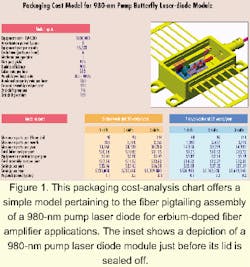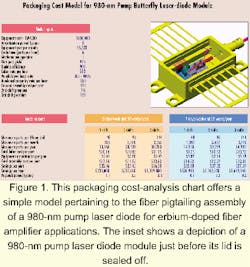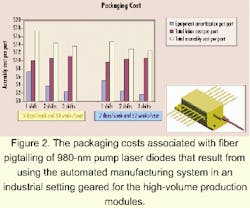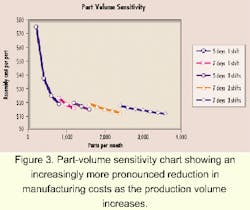Automated manufacturing systems for high-volume packaging of fiber-optic components
A lack of fully automated production lines is resulting in a shortage of fiber-optic components.
Kamran S. Mobarhan, Ph.D., and Randy Heyler, Newport Corp.
The demand for optical-network components based on wavelength-division multiplexing (WDM) technology is increasing rapidly. But many sales opportunities are missed because manufacturers can't assemble these devices fast enough. This has led to a worldwide shortage in commercially available fiber-optic WDM components. The problem is mainly due to a lack of fully automated production lines in the optoelectronic device manufacturing factories.
Fiber-optic components are tiny, yet highly sophisticated products designed for performing specific high-tech functions. In this regard, these components are not much different from a fine Swiss watch. Unfortunately, the way fiber-optic components are currently manufactured resembles that of a watch factory in the days before automated assembly. Essentially, the manufacturing is done in a manual or semi-manual fashion where the assembly line involves hundreds of workers sitting at workstations assembling the parts. Optoelectronic device module packages are not fundamentally designed with automation in mind.Consequently, the manufacturers of these components find it difficult to ramp-up capacity to meet the global demand for these products. Moreover, it's not feasible to continue to expand production in this fashion. As a result, industrial manufacturers are seeking automation systems for the purpose of automating the fiber-optic component manufacturing process.
A strong trend among emerging companies is to outfit manufacturing facilities with automated photonics-packaging systems from the beginning. In this fashion, once these manufacturers are through with a component's proof of concept and prototyping phase, the launch of a high-volume production operation is almost immediate. In many cases, these companies purchase identical machines for the prototyping laboratory and their production lines. With global pressure increasing for the time-to-market of a new product to be on the order of months, this strategy has proven to be the most economical.
The time and financial savings of automated component assembly are best illustrated by an example of a specific device's automated manufacturing process and the associated cost model.
A laser-welding workstation is used for packaging of 980-nm erbium-doped fiber-amplifier (EDFA) pump laser-diode modules and 1,550-nm wavelength distributed-feedback (DFB) laser modules (see Photo). This automated manufacturing system is suitable for high-volume production of components as well as research and development and prototyping applications. As a result, it is possible to develop a new product and launch its production operation on the same manufacturing platform.It takes the operator about two to three minutes to load the device and all the assembly components into the machine and set up the unit for the execution of the packaging sequence, which includes a laser-welding process. The machine will first automatically perform the alignment of the optical fiber to the laser-diode waveguide chip. In the case of a 980-nm pump laser-diode module, this step in the process takes about one minute to a minute and a half to perform. Following this step, a pre-welding metrology is performed in order to establish the optimum coupling efficiency possible with the particular device under test. This pre-welding metrology takes about one minute; it includes a light versus current measurement (L.I. curve) and spatial profiling. Subsequently, the components are attached to each other using a rapid laser-welding process that typically lasts about 30 sec.
For some ultra-high-precision applications, it may be necessary to perform an automated post-weld adjustment. Depending on specific package geometry and optical train design of the device module, the post-weld adjustment could include either a laser-hammering process or laser hammering in conjunction with a fine automated mechanical adjustment. This step of the process takes approximately one to three minutes. At the end of the process, a final post-weld metrology is performed, the fiber input snout of the module is soldered off, and the device is unloaded from the machine. All this, including a final L.I. curve measurement, takes about one to three minutes to do. The total process time from start to finish for a 980-nm pump laser-diode fiber pigtailing application ranges from seven to 11 minutes.
Figure 1 shows a cost model chart for the packaging cost of a 980-nm laser-diode module used as a pump source for EDFAs. This model can be used to predict achievable parts throughput and assembly cost per part for various application scenarios.A laser-welding workstation costs roughly $350,000 to $410,000, depending on the options, specific toolings, and fixtures. A medium number of $380,000 is used in the cost model presented here. Based on the 980-nm laser-diode module assembly process described earlier, a 6-parts-per-hour cycle time corresponding to a 10-minute-per-part throughput for one machine and one dedicated operator per machine is assumed. The amortization period for the machine is five years, which is typical for many capital pieces of equipment.
The fully automated turnkey design of the workstation and the minimal amount of maintenance it requires to operate smoothly, gives rise to a first-pass yield of about 95% and uptime efficiency of 90%. A $13-per-hour value is chosen as the cost of paying an operator to load and unload the devices into the machine and monitor the entire process. The machine automatically executes the process sequence associated with the fiber pigtailing of the 980-nm pump laser-diode module. At a variable overhead rate of roughly 300% to 400%, the total burdened assembly rate is about $50 per hour. It is estimated that the current assembly cost per part using less-automated methods is about $50 per part.
The model depicted in Figure 2 shows that tens of thousands of parts can be manufactured in one year using one automated machine. At a burdened assembly rate of $50 per hour, the labor cost per part is about $10. This number is based on the burdened assembly rate per hour, the number of hours one worker works per year, and the total number of parts produced by each machine. To calculate the equipment amortization cost per part, divide the total machine cost by the amortization period and by the maximum parts produced per year. This results in a machine amortization cost-per-part value of less than $10, which decreases linearly as volume grows and shifts are added. The fully burdened assembly cost per part is then the sum of the machine cost per part and the labor cost per part, which ranges from $10 to $20 depending on total volume throughput.To estimate the payback period for this type of equipment, we compare the current cost ($50) to the median cost using automated assembly (say $16), which translates into a savings of $34 per part. Using automated manufacturing machines, this number can be reduced to about $16 per part, which translates into a savings of $33 per part. At a rate of over 10,000 parts manufactured per year per machine, the money saved through the use of automated machines and techniques adds up to approximately $350,000 per year.
Therefore, the automated manufacturing system pays for itself in just over one year. If the system is operated seven days per week instead of five, the payback period is decreased to about eight-and-a-half months. Operating the machine at the full capacity of three shifts per day results in a payback period of less than three months. Figure 2 tabulates these packaging costs, and Figure 3 shows that the higher the volume of parts manufactured, the greater the cost savings.
It is possible to achieve high production yields and dramatically decrease operational costs by adopting automated techniques. The use of automated manufacturing systems in high-volume production of fiber-optic components can enable manufacturers to quickly and economically scale manufacturing volume as well as drastically reduce the training requirements and operator dependency of the assembly process.
Kamran S. Mobarhan, Ph.D., is marketing manager, technology and applications and Randy Heyler is vice president, photonics packaging and advanced automation systems, for the fiber-optics and photonics division of Newport Corp. (Irvine, CA). The authors can be reached via e-mail at [email protected] and [email protected].



